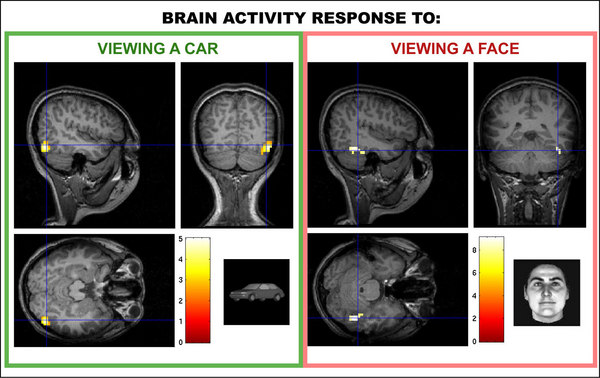By STEVE AISHMAN
"The human brain is a cultural artifact."--Timothy Taylor
Have you ever been standing at the baggage claim watching the luggage go around and you swear that every piece of luggage that comes around looks like yours?
Well, it happens to me and I end up checking the tags of four or five bags that vaguely match the qualities of my bag. I once spotted and correctly identified someone I had gone to kindergarten with 20 years ago across a crowded subway out of the corner of my eye, but for the life of me, I'm never really sure what my own baggage looks like.
It turns out that the phenomenon of not being able to identify one's own luggage, but having an exceptional ability to visualize and remember faces is completely normal. When our brains are presented images of faces, very different and larger sections of our brains activate then when we are presented with images of other objects. The way our brains are designed to process different visual stimulation makes logical sense because being able to differentiate between human faces is a much more important survival skill than the ability to identify luggage.
Understanding this fact is extremely important to me as an artist because it means one simple thing: when people are exposed to various visual stimuli, their brains are affected in significantly different ways.
This fact partially explains why some people do not enjoy looking at new things, but prefer seeing the same things over and over again. When the brain receives visual stimulation that it has previously processed, it simulates the same sections again, but when faced with new stimulation, the brain has to work hard and activate new sections in order to determine how to process the stimulation. Therefore, the desire for homogeneity of visual stimulation makes a certain amount of logical sense. Most people are risk averse and the mental ease that accompanies seeing the same things repeatedly makes the viewer feel like they are taking fewer risks. Logically then, since most people are risk averse, most people are also visually risk averse.
However, there could be extremely great benefits to taking more visual risks. For the past century, there have been massive gains in IQ points from one generation to the next. This phenomenon is called "the Flynn effect" after psychologist James R. Flynn. There are a great number of potential reasons for this effect ranging from the possibility that the tests are fundamentally flawed to simply better nutrition in the general population. Another explanation for the gain in IQ points is that environmental changes due to modernization have meant that people are utilizing more of their brains in more complex ways than they have in the past. The Oct. 2007 Scientific American Mind Magazine describes this phenomenon. An example of how this expanded use of mental capabilities over the past few generations can be seen in the development of television shows. In the 1950's, shows like "I Love Lucy" revolved around three or four characters in one location at one time, while contemporary shows like "24" involve dozens of characters in multiple locations over large spans of time. Watching contemporary television requires the viewer's brain to coordinate memory, location and a host of other functions in ways that were not used even one generation back on such a regular basis.
This does not mean that people in past generations were not as smart as people today, but it means that they may have used their brains differently. When asked a question like," What do a dog and a cat have in common?" a large proportion of the modern population will answer that they are both mammals, which is an abstract answer while people a century ago would have been more likely to answer that a dog chases a cat, which is a concrete answer. Neither answer is incorrect, but the abstract answer requires a more complex thought process.
If the hypothesis that stimulating different parts of the brain in complex ways can lead to a higher IQ is correct and if the brain responds differently to different visual stimuli, isn't it logical that if you seek out new and different visual art, you will benefit from your brain's added activity?
So in other words, shouldn't everyone be out looking for the newest and wildest art even if they don't like it? And as artists, isn't part of our job to provide new ways of seeing rather than re-hashing visuals that our brains already know how to process? Maybe making work that most people cannot relate to and therefore do not like is an acceptable goal...
So do yourself a favor, rather than just making a New Year's resolution to get back in the gym to make your body stronger, why not make your mind stronger by seeking out visual art that you've never seen before?




